This post is meant as an aid to snake identification. In addition to posting photos of all the snakes, I try to point out color variations within a species, where the species is found in Ohio, and what the typical length of an adult is. I have tried to group snakes to make it easier to distinguish between similar-looking species.
I focus on the visual characteristics of the snakes; for a more detailed description of the snake (its habitats, behavior, etc.), I have provided links to three sources for each species:
- ODNR: Ohio Department of Natural Resources
- OPLIN: Ohio Public Library Information Network (includes a map for each species showing its range within Ohio)
- Wikipedia (sometimes there is not specific information on the subspecies identified here, and instead there’s a link to the more general species).
Venomous Snakes
Family Viperidae
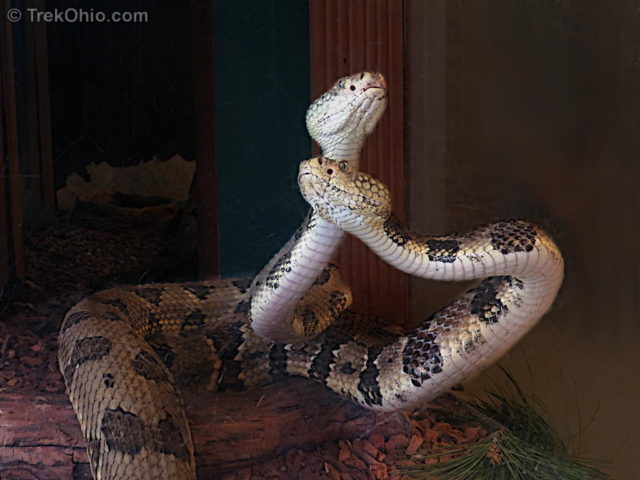
Two Timber Rattlesnakes (Crotalus horridus)
Length: 36-54 inches
Color: yellow to brown background with dark brown or black bands across the back.
Location in Ohio: far south of state; before 1960 it was also seen on islands in western Lake Erie and on the Catawba and Marblehead Peninsulas.
Ohio Division of Wildlife video: Timber Rattlesnake: Scioto County, August 18, 2012
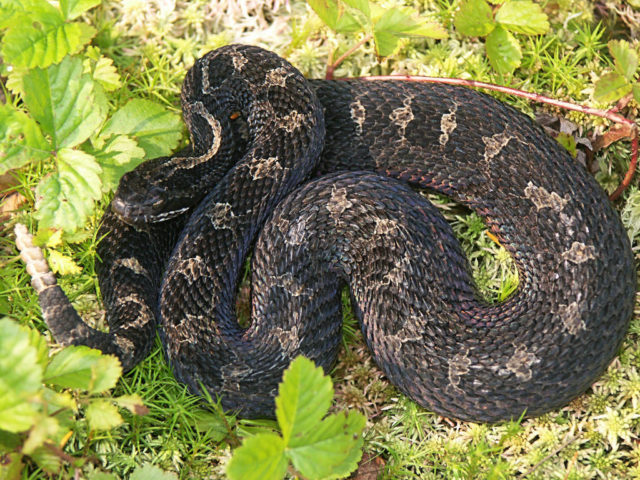
Eastern Massasauga Rattlesnake (Sistrurus c. catenatus)
Length: 20-30 inches
Color: background is gray or brownish-gray with darker splotches;
Black bands running from eye to corner of mouth; another band goes over the head
Location in Ohio: glaciated parts of western and northern Ohio.
The above rattlesnake species above are the only ones with a true rattle. However many species of snake will vibrate their tail when they feel threatened. If they are in dry leaf litter, this may sound like a rattle.
Pictured below is the Northern Copperhead. Sometimes the Eastern Foxsnake is mistakenly believed to be a copperhead because some individuals have a copper-colored head.
Two Northern Copperheads (Agkistrodon contortrix mokasen)
Length: 24-36 inches
Location in Ohio: eastern half of state (excluding far north) plus the southwest corner of state
The venomous water moccasin or cottonmouth does not occur in Ohio.
Pretends to be Venomous, but it’s not
Family Colubridae
I am singling out the Eastern Hog-nosed snake here because it does such a convincing job of behaving like a venomous snake. When alarmed it flattens its neck, puffs out its body, coils and strikes aggressively at the perceived threat. Some people who feel threatened by this play-acting end up killing the snake, so in those case the strategy sadly backfires.
As a second line of defense, the Eastern Hog-nosed snake will play dead by flipping over on its back with its tongue hanging limply from its open mouth. To make its act as convincing as possible, it even tries to smell like a corpse. It releases a foul-smelling musk and may have a bowel movement. The Tennessee Wildlife Resources Agency has a nice photo of the snake playing dead here.
The upturned nose that gives the snake its name is used to dig up its prey, usually toads.
Eastern Hog-nosed Snake (Heterodon platirhinos)
Length: 18-30 inches
Color: gray background with black splotches, or yellowish-brown background with darker brown splotches (see below).
Location in Ohio: the south, the central region, and the northwest.
In the above photo, note the upturned nose which gives the snake its name.
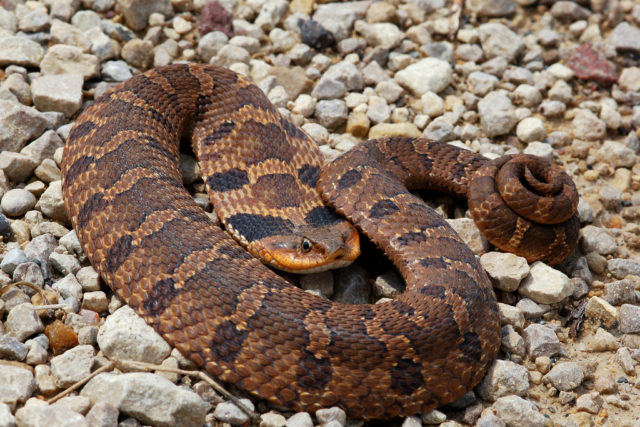
Eastern Hog-nosed Snake (Heterodon platirhinos) — Eastern Hog-nosed Snake flattening its neck to create a cobra-like hood.
Nonvenomous Snakes
Family Colubridae
Aquatic Snakes
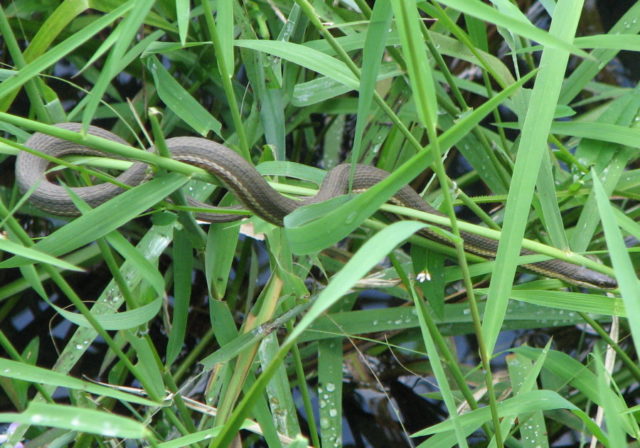
Queensnake (Regina septemvittata)
Length: 15-24 inches
Color: olive-brown, chocolate-brown or black with a yellow stripe running low along its sides
Location in Ohio: Widely distributed
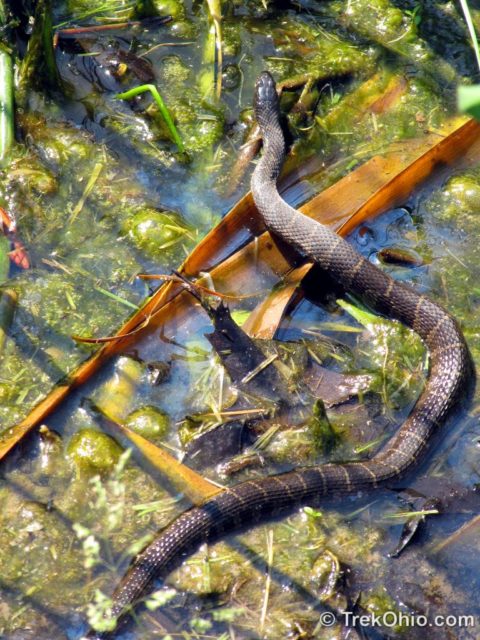
Common Watersnake (Nerodia sipedon sipedon)
Length: 24-42 inches
Color: the back may be reddish-brown, brown, gray or black with bands or blotches across it; becomes darker as it ages; the belly is white, yellow, or gray with spots.
Location in Ohio: Widely distributed
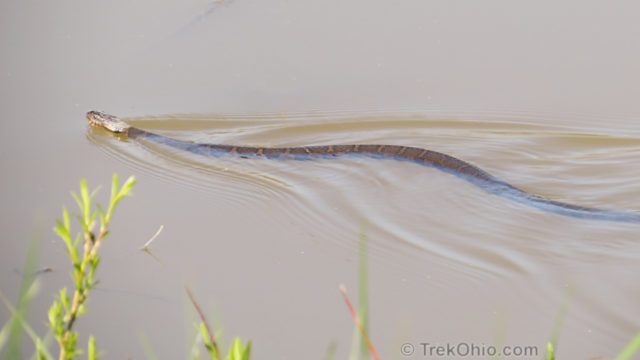
Lake Erie Watersnake (Nerodia sipedon insularum)
Length: 24-42 inchesColor of back: grayish, greenish, brownish;
Color of belly: white or pale yellow, occasionally with pinkish tinge down the middle
Location in Ohio: Islands of Lake Erie
Another aquatic watersnake that I’ve grouped with Snakes having Reddish Bellies is the Copper-bellied Watersnake seen below.
Snakes with Reddish Bellies
Copper-bellied Watersnake (Nerodia erythrogaster neglecta)
Length: 24-42 inches
Color: back is black or brownish black; belly is orange-red or red
Location in Ohio: Williams County; possibly scattered remnants elsewhere
Northern Ring-necked Snake (Diadophis punctatus edwardsii)
Length: 10-15 inches
Color: background is olive, brown, gray or black; the neck ring is yellow, orange, cream or white.
Location in Ohio: southern, eastern, and central Ohio, plus the border around Lake Erie
The Northern Red-bellied snake (pictured immediately below) has three, light-colored scales at the base of the head, while Kirkland’s snake (its picture follows the Northern Red-bellied snake) does not have this light-colored blob to the rear of its head. Another difference is that the Kirkland’s snake has black spots running down each side of its belly, but the belly of the Northern Red-bellied snake is a uniform red.
Northern Red-bellied Snake
(Storeria occipitomaculata occipitomculata)
Length: 8-10 inches (20-25 cm)
Color: background color is gray, or gray-brown with four stripes running down the back that are slightly darker
Location in Ohio: located in a diagonal band going from south-central Ohio through central Ohio to northeast Ohio; also found in a small pocket in northwest Ohio.
Kirtland’s snake (Clonophis kirtlandii)
Length: 14 – 18 inches
Color: The back is brown or gray with large, dark spots on each side; the belly is reddish with smaller dark spots running down each side.
Location in Ohio: most of Ohio except for the far east and far south; most common in Lucas and Hamilton counties
Both of the wormsnakes below have pink bellies; the color may vary from light pink to coral pink. The belly scales tend to be somewhat translucent so it may be possible to make out some of the snake’s internal organs while looking at its belly. The top is brown or pinkish-brown, with younger snakes being a darker brown than older snakes.
The head is very small and pointed with tiny eyes. The tail of both species tapers to a sharp point. Some people think this is a stinger, but it is not. It is believed that the pointed tail may be used in digging into the earth.
The only real difference between the Eastern and Midwestern wormsnakes has to do with the scales on the top of the head from the eyes to the snout. These scales are fused for the Midwestern wormsnake, while they remain separate for the Eastern wormsnake.
Eastern Wormsnake (Carphophis amoenus amoenus)
Length: 7.5-11 inches
Color of back: pinkish-brown, brown, dark brown; Color of belly: light pink to coral pink
Location in Ohio: southeast and south-central Ohio.
Midwestern Wormsnake (Carphophis amoenus helenae)
Length: 7.5 – 11 inches
Color of back: pinkish-brown, brown, dark brown; Color of belly: light pink to coral pink
Location in Ohio: southern third of the state.
Brown snakes
Both the Northern and Midland Brownsnakes have two dark lines running down their backs. However the Midland Brownsnake also has some dark lines crossing over its back creating a ladder-like look. The two species do interbreed producing what are called intergrade offspring with characteristics of both parents.
The distribution of the population in Ohio has something of a “T” shape; it is found in most of northern Ohio, and in a band that runs from north to south through the center of Ohio.
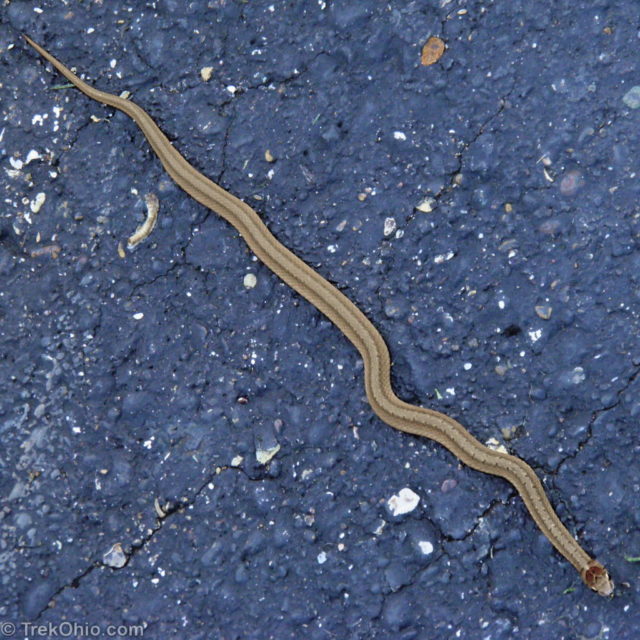
Northern Brownsnake (Storeria dekayi dekayi)
Length: 9 – 13 inches
Color of back: brown with two parallel lines of dark spots running down its back; Color of head: Dark brown on top, with thin, brown marks on the sides of the head
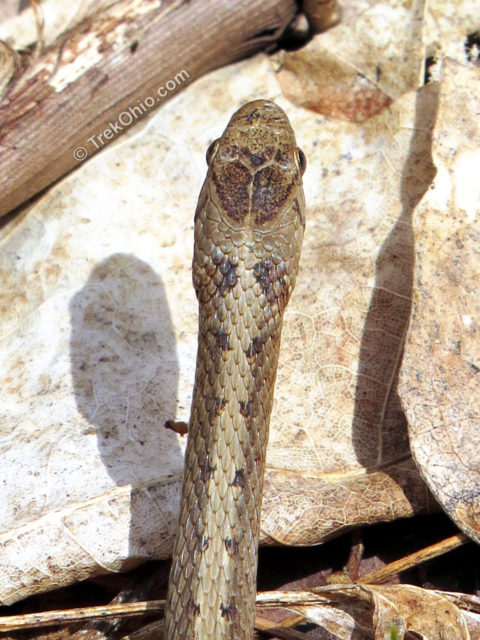
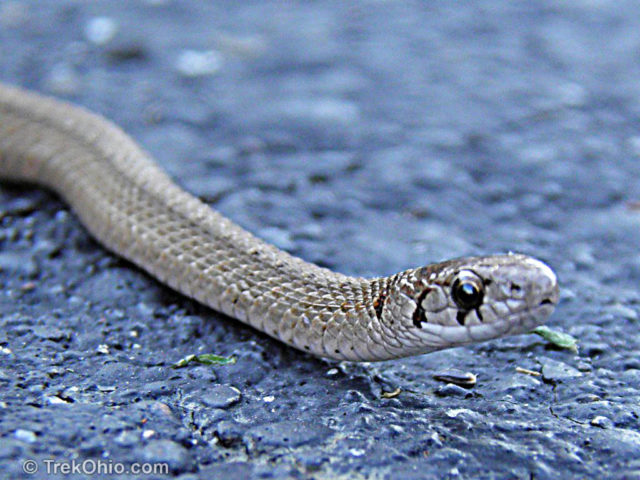
Both the Northern and Midland Brownsnake head have dark brown marks on the side of their heads.
Midland Brownsnake (Storeria dekayi wrightorum)
Length: 9 – 13 inches
Color: Black lines cross its back; otherwise the coloration is like the Northern Brownsnake.
Location in Ohio: most of the state except unglaciated southeast
Unlike the brownsnakes above, the Eastern Smooth earthsnake below does not have any distinct markings on its back and it has a stouter body.
Eastern Smooth Earthsnake (Virginia valeriae valeriae)
Length: 7-10 inches
Color of back: gray or reddish to yellowish brown, sometimes with a faint stripe going down the middle of its back. Color of belly: white or yellowish
Location in Ohio: central portion of the south, especially Shawnee and Pike State Forests.
Gartersnakes & Ribbonsnakes
The following are a few differences between individual species that have helped me to make an identification.
- Unlike the Eastern Garter snake, the Plains garter snake has two, light-colored spots on the top, rear part of its head; they’re called parietal spots.
- Unlike Garter snakes, the Eastern ribbonsnake has a thin, white vertical mark in front of each eye. If interested you can check out this close-up photo of an Eastern ribbonsnake’s head where the white mark is plainly visible.
- To distinguish between an Eastern Garter snake and a Butler’s Garter snake, note where the lateral (side) stripe is relative to the snake’s ventral (belly) scales. The lateral stripe is found on the second and third scales of the Eastern Garter snake. However this stripe is centered on the third scale of the Butler’s Garter snake, with the coloration extending up halfway on the fourth scale and down halfway on the second scale. The photo below shows how to count scales on a snake.
Eastern Garter Snake (Thamnophis sirtalis)
The lateral stripe on an Eastern Garter snake is present on the second and third scales when counting the scales diagonally starting with the first scale next to the ventral scale.
The scales above this snake’s head also illustrate what is meant by keeled scales. Scales are said to be keeled if they have a ridge running down the middle.
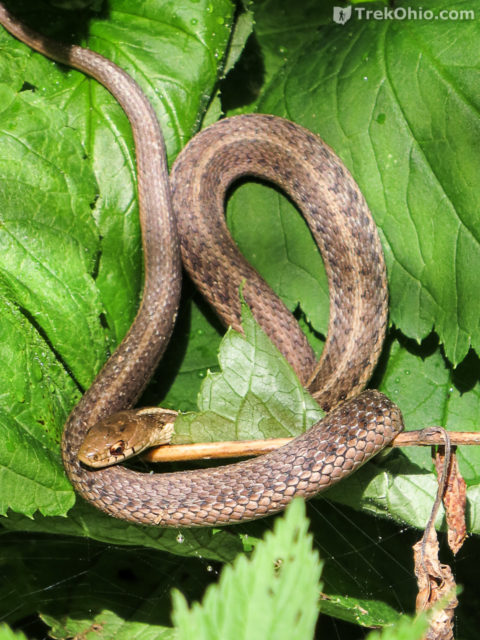
Eastern Garter Snake (Thamnophis sirtalis)
Length: 18-26 inches
Color: background may be black, brown, green, or olive. The stripes may be yellow, or orange.
Location in Ohio: Widely distributed throughout the state
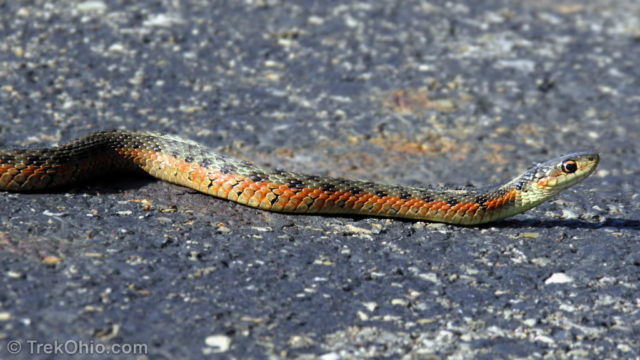
This one has an orange stripe.
Plains Gartersnake (Thamnophis radix)
Length: 20-28 inches
Color: background is brown, green, or reddish with yellow or orange stripes
Location in Ohio: Wyandot and Marion Counties
Butler’s Gartersnake (Thamnophis butleri)
Length: 15-20 inches
Color: background is olive-brown to black with yellow to orange side stripes.
Location in Ohio: northwestern quadrant of Ohio
Short-headed Garter Snake (Thamnophis brachystoma)
Length: 18-26 inches
Color: Background color is olive to olive-brown. Lateral (side) stripe is yellow or light beige. Like the Eastern Garter Snake, the Short-headed Garter Snake has lateral stripes on the second and third scales. Unlike the Eastern Garter Snake, there are no black spots between the stripes of the Short-headed Garter Snake. Unlike the Ribbonsnake, there is no white line in front of the eye of the Short-headed Garter Snake.
Location in Ohio: Found in two to three eastern counties in the state.
PA Herps provides more information on this snake, including a photo gallery..
Common or Eastern Ribbonsnake (Thamnophis sauritus sauritus)
Length: 18-26 inches
Location in Ohio: northern and east-central Ohio.
Green snakes
The Rough Greensnake has keeled scales, while the Smooth Greensnake does not. I don’t have a close up photo of the scales of the Rough Greensnake, but I can give you an idea of what I mean by keeled scales. There is a close up view of the keeled scales of the Eastern Gartersnake earlier in this post (it’s the same photo that labeled some of the snake’s scales as ventral scale, 1, 2, 3). If you look at the scales above the garter snake’s head, you’ll see little ridges going down the middle of each scale. These ridges are said to be the scale’s keel.
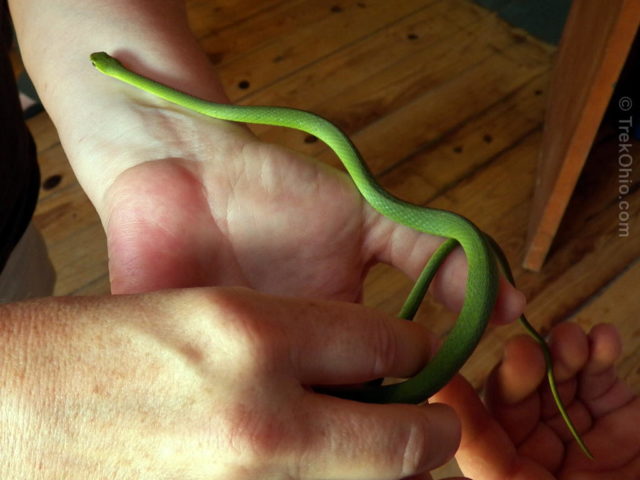
Rough Greensnake (Opheodrys aestivus)
Length: 22-32 inches
Location in Ohio: extreme southern counties
Smooth Green Snake (Opheodrys vernalis)
Length: 14-20 inches
Location in Ohio: northeastern quadrant and southwest corner
Ohio Division of Wildlife Video: A Closer Look: the Smooth Greensnake
Black and Blue Snakes
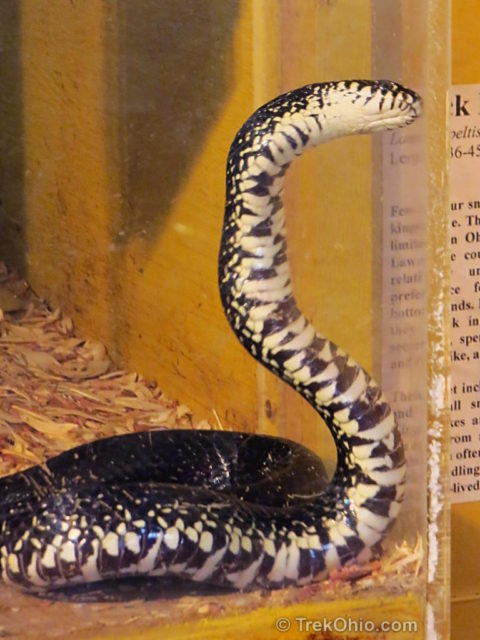
Eastern Black Kingsnake (Lampropeltis getula nigra)
Length: 36-45 inches
Color: the back may be solid black, or it may have a faint chain-like pattern; the belly is a checkered black and white.
Location in Ohio: central portion of the extreme south of the state
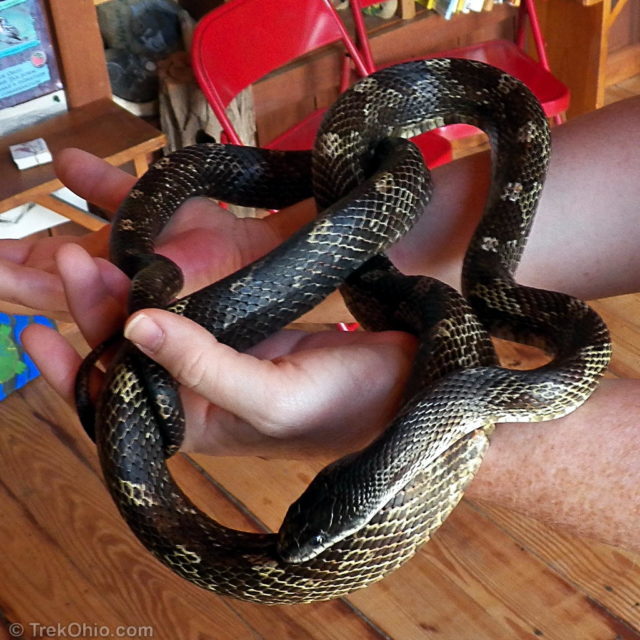
Eastern Ratsnake (Pantherophis alleghaniensis)
Length: 47-72 inches (largest snake in Ohio)
Color: juvenile is gray with splotches, but the snake gets darker as it matures
Location in Ohio: Widely distributed
UPDATE: Formerly ODNR listed the Eastern Ratsnake as the largest snake in Ohio; now it has re-classified this snake in its species index as the Gray Ratsnake (Pantherophis spiloides).
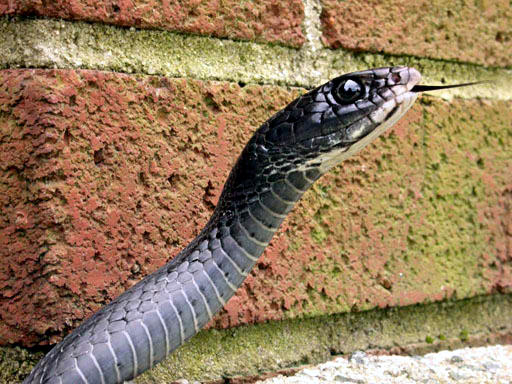
Northern Black Racer (Coluber constrictor constrictor)
Length: 36-60 inches
Color: black with white chin and throat
Location in Ohio: east and southeast
Blue Racer (Coluber constrictor foxii)
Length: 36-60 inches
Color: Black to bluish black with white chin and throat
Location in Ohio: western, central, and northern Ohio
Melanistic snakes: These are black variants of snake species that normally are not black. Species that have melanistic individuals include the Northern red-bellied snake, the Eastern Hog-nosed snake, the Queensnake, and the Timber Rattlesnake. And up around Lake Erie, there is a melanistic variety of the Eastern Garter Snake like the one pictured below.
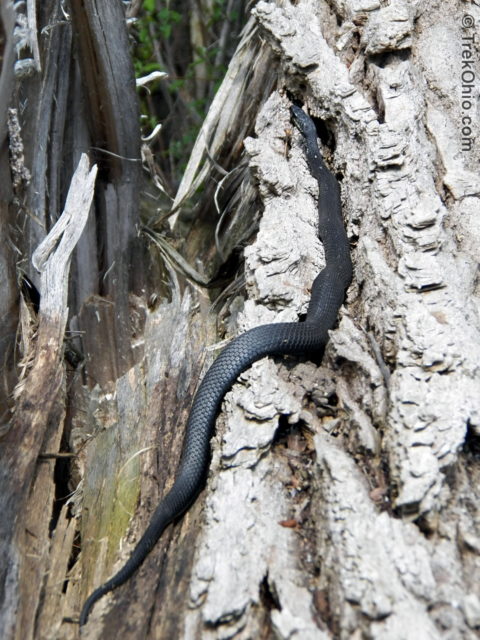
Bold Markings
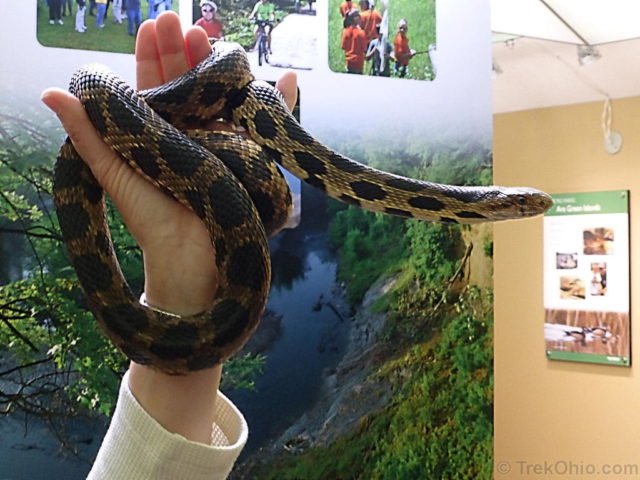
Eastern Foxsnake (Pantherophis gloydi)
Length 36-54 inches
Color: background is yellowish to light brown with dark brown to black splotches.
Location in Ohio: Western end of Lake Erie and its islands
Ohio Division of Wildlife video: Eastern Fox Snake
The milksnake (below) is sometimes confused with the copperhead. The copperhead has bands of color, whereas the milksnake has big, irregularly shaped spots.
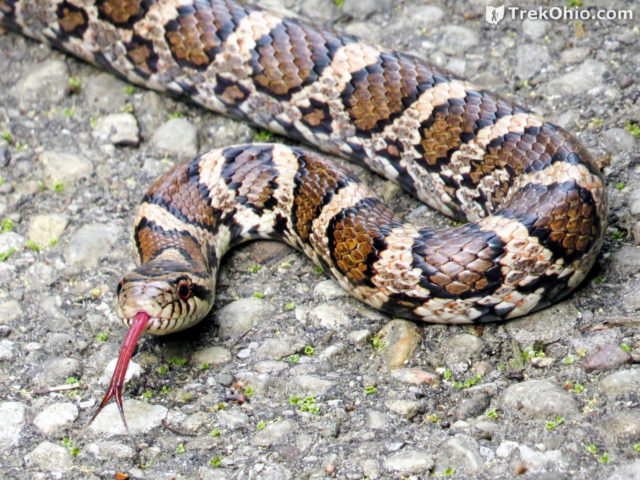
Length: 24-36 inches (60-91 cm)
Color: background is gray or tan; irregular spots are reddish-brown to brown and rimmed with black.
Location in Ohio: Widely distributed throughout state
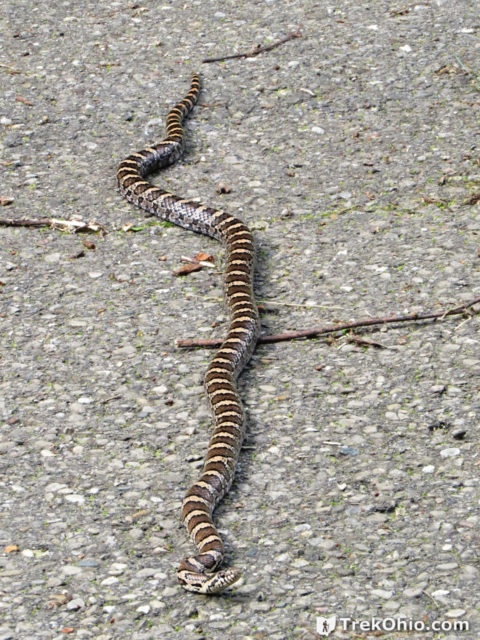
The Eastern milksnake is also distinguished by markings on its head and belly. When viewed from the top, the milksnake has a dark band between its two eyes. When the head is viewed from the side, there is a dark band starting at the eye and slanting down and back toward the belly.
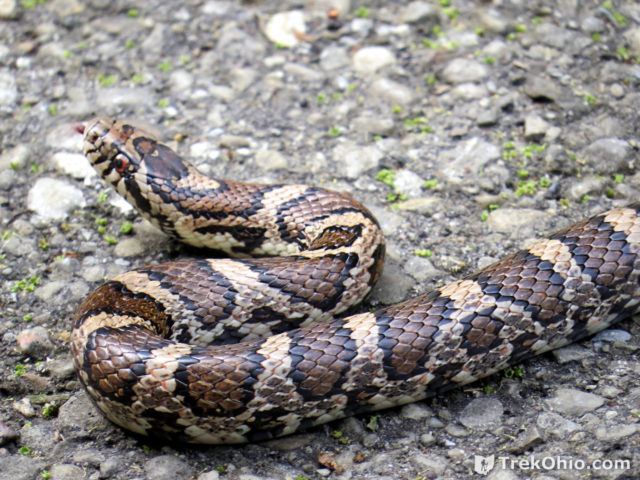
The milksnake also has distinctive markings on its belly. It has nearly rectangular blotches distributed irregularly on its ventral plates. The belly rectangles kind of look like the drawing below:

Image attribution
Whenever we included a third party’s photo in this article, we have identified the photographer and the photo’s license immediately above the image. I am grateful to these individuals for sharing their photos. When no photographer listed immediately above the photo, the photo is one that we’ve taken ourselves.
Additional reading
- ODNR: Reptiles of Ohio Field Guide (PDF)
- ODNR: Licensing and Regulations for Reptiles – what you should know if you are interested in capturing a wild animal for your terrarium.
- Buckeye Herps Blog: Ohio Snake Identification – Venomous or Not? – How to identify Ohio’s venomous snakes.
- OPLIN (Ohio Public Library Information Network): What’s That Snake?
- Center for North American Herpetology: A Pocket Guide to Ohio Snakes (PDF)
- Distinguishing between similar-looking species:
- GarterSnake.info: Telling Garter Snakes and Ribbon Snakes Apart – For me one of the easiest-to-note differences was that ribbon snakes have a white, vertical mark in front of their eyes, but garter snakes don’t.
- iNaturalist.org: Telling Garter Snakes and Ribbon Snakes Apart
- How to Identify a Brown Snake (Storeria dekayi) – how to distinguish among Midland brownsnakes, Northern brownsnakes and juvenile ratsnakes.
- Eastern Wormsnake – How to distinguish between Eastern and Midwestern wormsnakes, as well as how to distinguish wormsnakes from other small brown snakes.
- Virginia Herpetological Society: the Eastern Ratsnake – nice series of photos showing the change in coloration as the snake matures; compared and contrasted with the Northern black racer.
- Pawnation: WHAT IS THE DIFFERENCE BETWEEN A ROUGH GREEN & SMOOTH GREEN SNAKE?
- ODNR: Nuisance Wildlife – dealing with human / wildlife conflicts (including snakes)
- A.L. Gibson: Copperhead vs Eastern Black Kingsnake! – blog post about an amazing life-and-death struggle between these two snakes. The whole struggle was documented photographically.
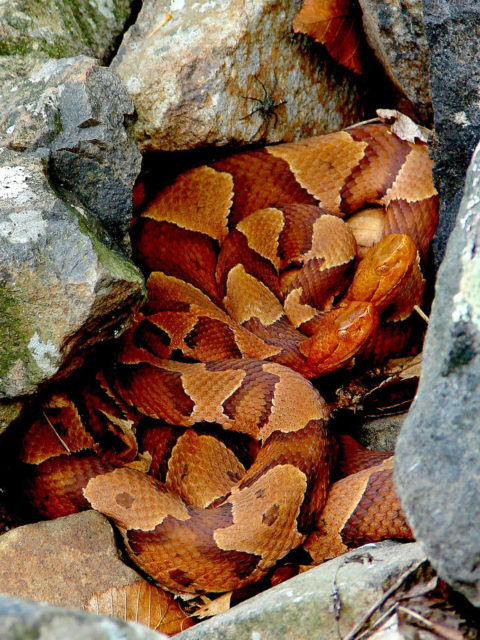
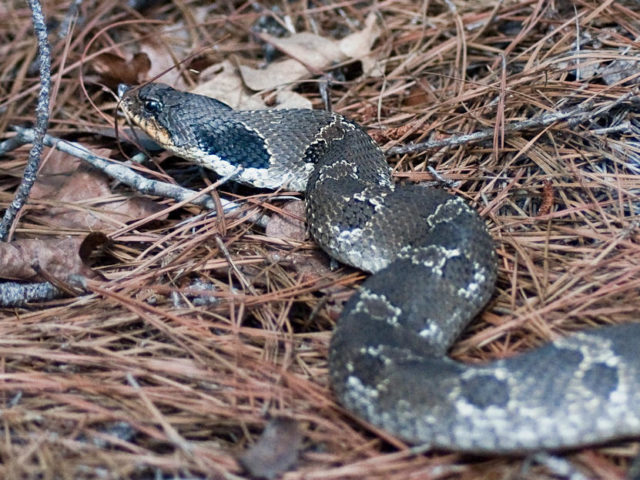
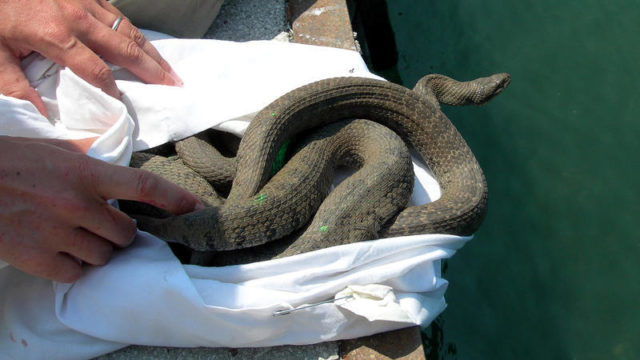
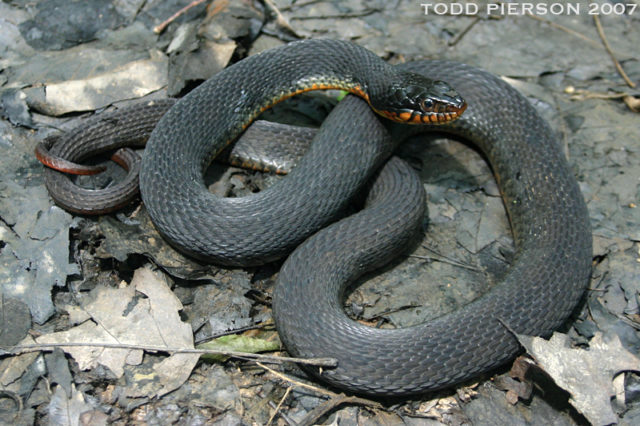
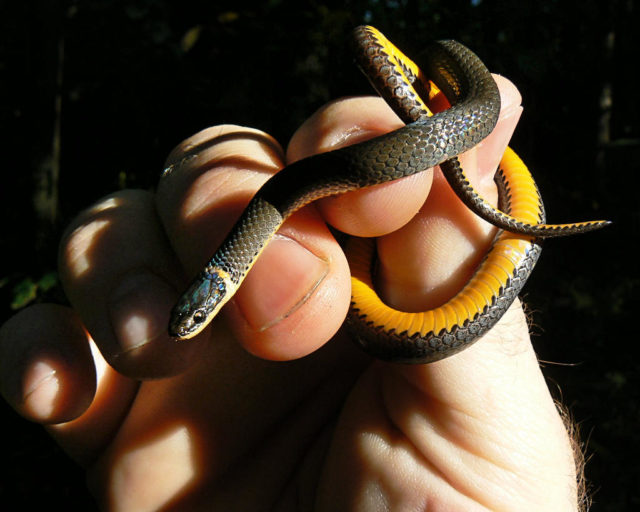
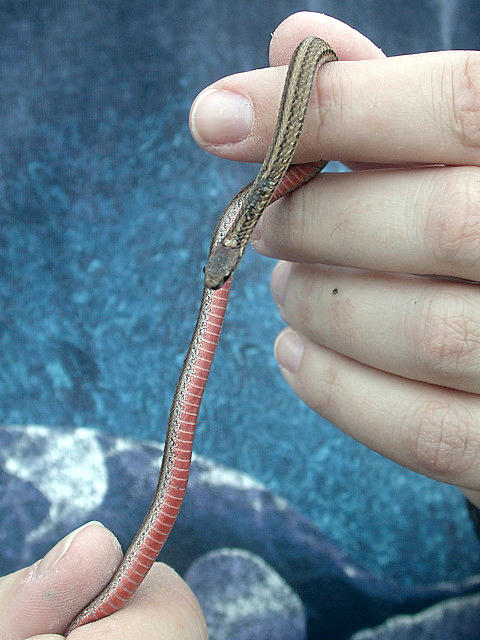
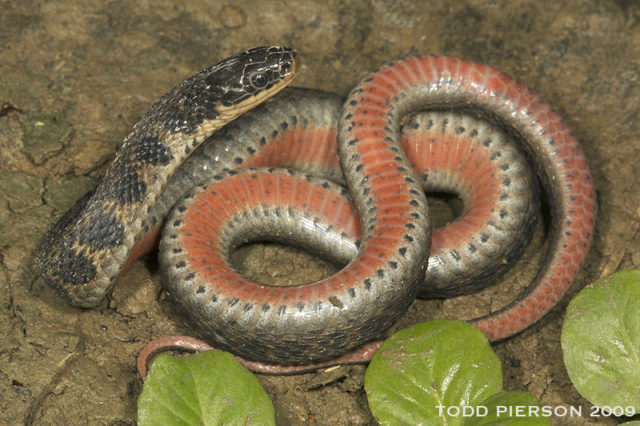
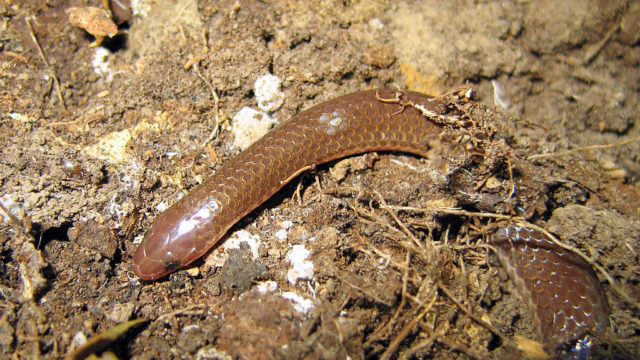
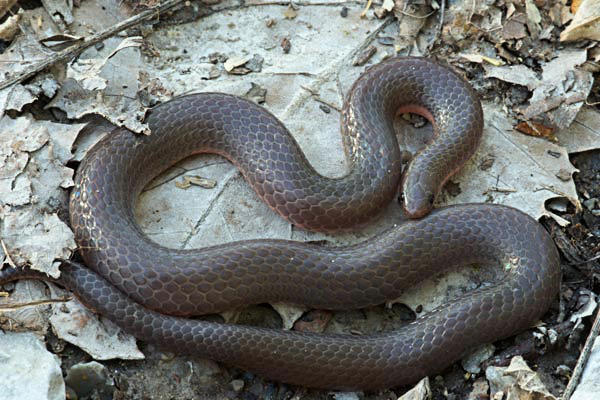
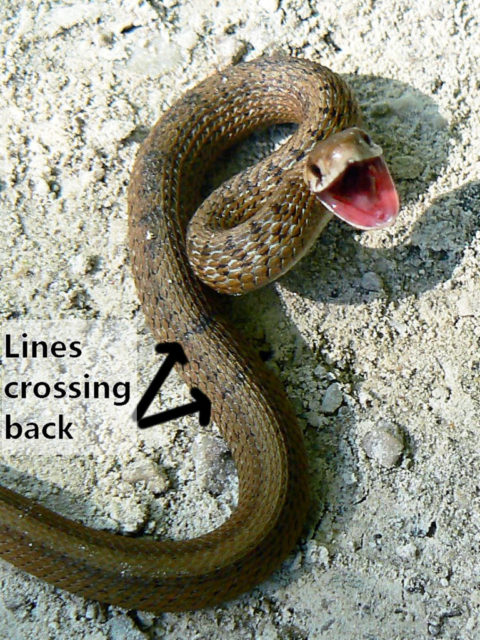
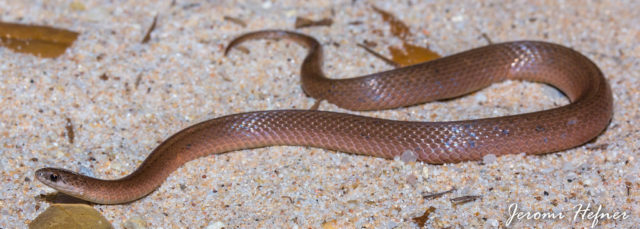
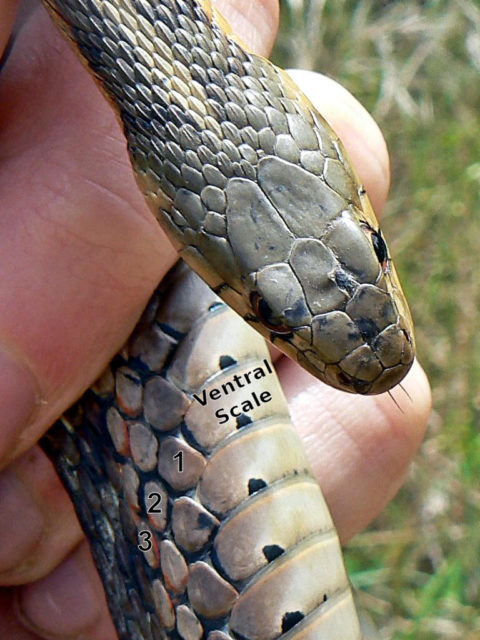
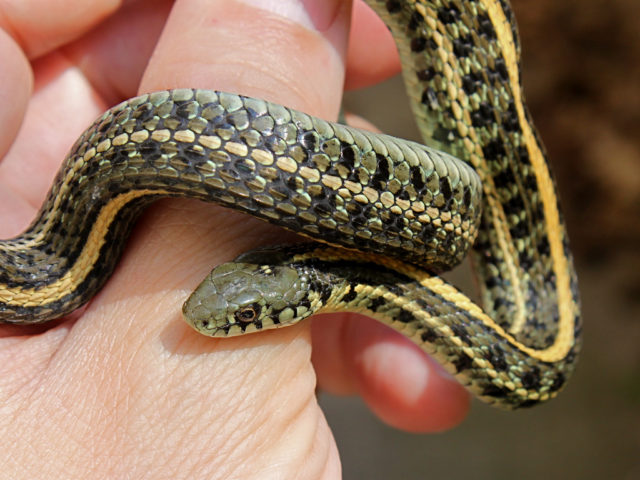
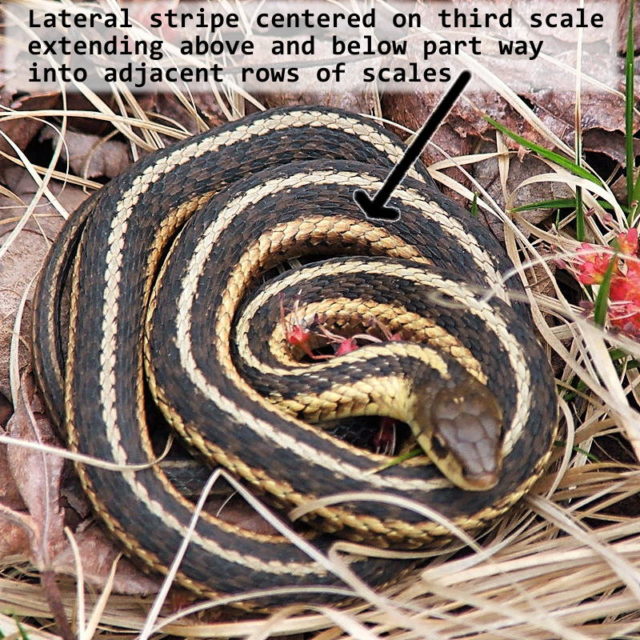


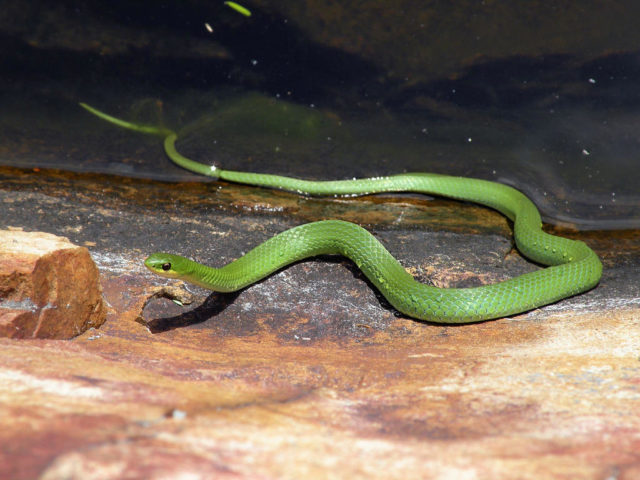
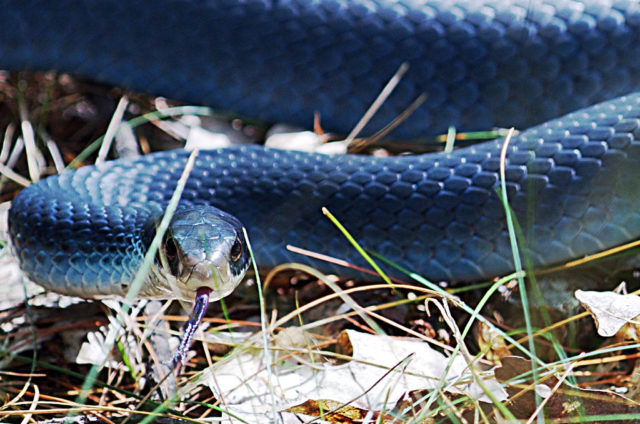
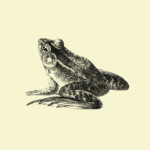
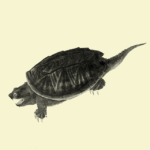
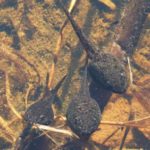
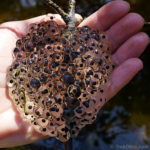
Yesterday morning, we had a large, quick snowfall, at least 3”. When I was running the snow blower, I found a snake (I think it was in the leaves in the rain gutter). In morning twilight, I couldn’t tell any real color. Whitish on the bottom, dark on top, almost 3’ long. I thought it curious that the snake was limp, not rigid (or frozen). The snake was possibly killed by the snow blower, but in these conditions, I’d have expected it to be frozen to death, or rigid from the cold. Any idea what kind of snake this was?
I live in rural Logan Co in a 170yr old house. This week I have found (so far) 3 small snakes in my house. I’m not a fan of snakes AT ALL so this has been quite an experience. We believe they have come up from under the house and have gotten in under the baseboards, which are not flush to the floor (0riginal floor and trim). I think they are kingsnakes, by the photos you have listed. How can I keep them out of my house??? I have a photo of the bellies but not the top.
I encountered this snake (see website) today. Could you please tell me its name and that if this snake is venomous?
At the photo’s resolution, I couldn’t make out all the details. If it is completely dark with a light chin, I’m leaning towards identifying it as a Northern Black Racer (Coluber constrictor constrictor). If there are any subtle patterns on the body, it might be an Eastern Ratsnake (Pantherophis alleghaniensis).
We have just bought property in Athens Ohio which has been ‘natural’ and undisturbed for a number of years. It is a combination of high grass meadow and ridged cliffs (used to be a raceway in the 40s). I am from the NW farm country and am not yet in tune with the ‘eastern’ habitation, as I understand is unique. What must be aware of prepared for when ‘cleaning’ the property?
I gather that you’re concerned about venomous snakes. There ARE venomous snakes in southern Ohio, but they are fairly rare. For specific recommendations, I’d contact an expert in either the Ohio Department of Natural Resources Division of Wildlife (1-800-WILDLIFE) or at Hocking College in Nelsonville – the school which trains a great many of Ohio’s naturalists.
I was walking along the railroad track in the grass by my home in rural Auglaize Co. looking for morels and came across a snake that looked nothing like any of the pictures. It was stripped in various shades of brown, probably about 36 inches long or more, and very big around, guessing about 7 inches at least. I do not like snakes at all so I didn’t hang around too long. Later that evening I had memories of that same snake in about the same area last year only it seemed larger this year.
hi linda, i was reading through these posts trying to identify a very large snake on my farm, (just a water snake), and saw that you once had a raceway on your property. i’m with the vintage american racing club of ohio and was wondering if you had any stories or history on the track, (i.e. photographs, name of track, old drivers/cars). feel free to email me.
I’m from Florida and moved to Ohio, Northwest Ohio. I would go out for hours watching and photographing snakes and gators. In Ohio however, I am shocked there aren’t that many snakes. I’ve been by the lake even and only once seen a bunch of black racers after weather was breaking at Maumee Bay State Park. That was only once, and they were everywhere! I love watching, playing and photographing snakes but am disappointed Ohio is low on snakes. At least all the areas I have been. Where’s the best place to go in Ohio? I really miss the snakes! Thank you! I love your site also, very informative!
Sorry for the delay in getting back to you. If you have a Facebook account, I think you would enjoy joining the “Herping Ohio” group on Facebook: https://www.facebook.com/groups/herpingohio/
Members of this group post photos of their snake sightings from all over Ohio (as well as sightings of other reptiles and amphibians). There are a number of naturalists and hobbyists who are more knowledgeable than I who frequently post to the group. It’s a great place to ask questions, too. I haven’t gone out hiking with the express purpose of spotting snakes, but there are many people in the group who do just that.
Because I do a fair amount of hiking, I do see snakes. I encounter more snakes than usual in the autumn because they spend so much time basking then. You can see common watersnakes in relatively small bodies of water. I’ve seen them in ornamental ponds. And every time I visit Dawes Arboretum’s “Cypress Swamp” in the summer, I’ve seen common watersnakes. Many of Ohio’s state parks have reservoirs, and I’ve seen a queen snake basking on a cement boat ramp near one such reservoir. I see garter snakes and brown snakes on the trail fairly frequently.
Summertime, Ohio River. Anywhere near the water. 🙂
Oh my. Come to Norwood,Ohio. We have thousands of snakes and lizards galore. My dog already caught a few. My neighbor had a family sunny on top of her bushes.The bad thing I am petrified of snakes.
Hey Tammy65. Ohio does have an ample supply of snakes, even in the Northwest area. It’s not necessarily a matter of where you go, but when. This year I started out in early spring (late March – early April)and continue on throughout the spring season. Usually after the “birders” have gone. One day while at Maumee Bay I stumbled across a garter snake mating ball in a lesser traveled part of the park. On another occasion I walked just a couple hundred feet past the nature center and found a large female fox snake. Another place to go is Ottawa National Wildlife refuge for garter and water snakes. And even Providence Park in Grand Rapids will provide a good showing of Northern Water snakes. I have not yet been disappointed, but I recommend getting out before the temps get too warm.
We live in Cincinnati (Hamilton County) and recently saw a large snake slithering out of our garage after having been away for several days. Our grass was also very long, and we live by a wooded area with a stream. Could you help us to identify it?
Em, did you take a photo of the snake? If you did, you can click on the “Contact” menu near the top of this page and send me a note. When I reply, you will have an email address so you can send in your photo.
My cat loves to hunt and I recently moved to Hamilton County in Cincinnati. I think he normally brings me Garter Snakes, but yesterday my gift was different. I didn’t take a picture, but he ended up at the vet’s office this morning with a high fever and was lethargic. When I scooped up the snake (still alive) into the dustpan, I noticed that it had a really pungent smell … never noted that with garter snake rescues. Any thoughts on what is in this area and gives off a pungent, musky smell?
Thanks, Mary
Mary, it sounds like your cat might have attacked an Eastern Hog-nosed Snake (Heterodon platirhinos). When threatened this snake first bluffs being an aggressive species of snake, and if that doesn’t drive away the predator, it tries playing dead. To make the playing-dead act as convincing as possible, it tries to smell like a corpse. Here’s an excerpt from the Wikipedia entry for this snake species:
The snake that you put in the dustbin may have actually been harmed by the cat, but it is also possible that it wasn’t injured at all.
I was in my backyard and saw a baby snake, it didn’t look like any kind of garter snake. By the time I came in to get my phone to take a picture he had gone into a little divot in the grass to hide. I did get a picture of his body a little bit. I don’t know what it is. If I can figure out how to post a picture I will haha.
I just found a hog nose snake that when it flattened itself out it did such a good job of it that even it’s eyes were indented. It was deep black, fairly short (18 inches or so), had the illusion of spikes on its back and hissed quite loadly at me. I know and care about snakes but this display unsettled me to the point that I did not even think to get a picture of it. Opportunity lost.
I wish I could have seen it. Sounds like it put on a great display for you!
Great information. Thanks! I saw a black and brown striped snake in my yard. Can I send you a picture? I live in the Cleveland area.
I have a natural pond near Allentown, Ohio. I have numerous Northern water snakes living and feeding around my pond. This afternoon my grandson was swimming in the pond and noticed a large water snake swim tot he bank. He flipped a town over it and picked it up by its tail. (30 inches appox.) Immediately I noticed it had a TRIANGULAR head. It’s bands were BLACK (Wide) and TAN (Narrow) but instead of being angled like a water snake they were STRAIGHT around the snake. The eyes were OVAL! It bite the towel and we could see it’s FANGS. I am SURE this was a water moccasin!–Yet we are told there are none in Ohio! I killed it because of the children swim in the pond. HELP! Are there water moccasins in Ohio!
Did you photograph the snake after you killed it?
At my home there is a long,fast,brownish-goldish colored snake that lives in our yard. Our mother is making us catch it and kill it. My 14 year old sister is scared of it biting her. What is it and does it bite?
Ohio has three species of venomous snake – here’s a link to an article about how to recognize them – http://buckeyeherps.blogspot.com/2011/09/ohio-snake-identification-venomous-or.html
Here’s ODNR’s advice on nuisance wildlife including snakes – http://wildlife.ohiodnr.gov/species-and-habitats/nuisance-wildlife
As long as the wildlife stays outside, I tend to leave it alone.
What is this???https://www.facebook.com/photo.php?fbid=10205637814979040&set=a.2047635364866.110098.1663898967&type=1
Ann, since you published the photo on Facebook, try joining the Facebook group, Herping Ohio, and asking them to identify it. The group is full of experts.
I’m almost 44 years old have seen many snakes.My friend and I use to cut firewood in Gallia county Ohio and found many rattlesnakes every year in our stacks of wood! You say in this article that rattlesnakes dont live in or near the central part of the state which maybe true for the most part but I found a rattlesnake 23 yrs ago at A.W.Marion State Park(Hargus Lake) on a gravel bank near the boat ramp on the State side of the lake! This lake is in Pickaway County East of Circleville.
Came across a snake at the Wildwood Preserve in Toledo. I took pictures but folks are still undecided on its identify. How can I post a pic so we know? Dark brown, black splotches on body with wide black stripes toward the tail. About 24-30 inches long.
Kate, can you upload it to a photo or social networking site, and then share the link to it here? For instance, post it to a site like Flickr, Smugmug, Facebook, Twitter, or similar site. If you post to a site like Facebook, you’ll have to make sure that the permissions for the post are “Public”. If you can’t do that, I could send you an email and you could respond with with an attached image.
This was not helpful at all, I found a brown with black strip snake in my back yard and can’t find anything to identify it , I’ll try to get a picture the next time I see them and yes them 3-4 little ones in the back of my yard by pool and garage area, I live in Toledo Ohio so if anyone has any idea as to what they are I would appreciate the information, thanks
Are there any venomous water snakes in Ohio?
Thanks for your response.
In the first paragraph the word “group” is doubled-up.
According to Wikipedia, the water moccasin (Agkistrodon piscivorus) is “the world’s only semiaquatic viper, usually found in or near water, particularly in slow-moving and shallow lakes, streams, and marshes…”, but this snake is not found in Ohio. However it turns out that any snake can swim. If you go to Google Images and search for “swimming rattlesnake”, you’ll see photos of swimming rattlesnakes even though rattlesnakes are not considered to be an “aquatic” or “semi-aquatic” snake. The water is not a rattlesnake’s preferred habitat.
Thanks for pointing out the double-up “group” phrasing.
Please help. Captured and released a snake in NE Stark County. Cannot identify it here, or on CNAH site. Trying to convince my friend he does not need to kill these to protect his pre-school children. Rural area, lots of farmland, some pasture land, not near water. Found in outbuilding. Snake was 15-16″, thin (smaller than a woman’s finger) dark charcoal/black back, no markings, pale/ cream belly. Head shape like black racer picture above (but this was a really small snake). Bright red tongue with black tip. When captured: emitted major quantity of musky cream colored feces from orifice 3″ from tail tip; opened its mouth as if to hiss (no sound); interior of mouth=white. He killed a probable garter snake (striped) earlier in the day; which I have now proved harmless. Need to identify this one. Thanks!
We’ve come across black snakes 6′ long. Is that uncommon?
I saw a beautiful snake slithering across my front steps. Only the rear half. It was an orange color with brownish diamonds on its back. I did not see a rattle but when I shook the bush it went under, I swear I heard a slight rattling. I am worried about my maltese. Can you help without a photo?
seen a snake years ago in clinton county doing toward a creek has a white mouth when closed. do water snakes hv white lips
It could be a Queen snake. Here’s a close up photo of its face taken by Patrick Coin and published at Wikimedia.org.
That is a Queen Snake.
interesting to hear there are no water mocassins in Indian Lake of Ohio…..people are claiming they see them all of the time….I was only seeing water snakes, so I am not crazy.
Theresa, many people believe that we have water moccasins, but our state naturalists assure us that Ohio is outside its range. There’s a nice map of the snake’s range in the Wikipedia entry for it (under its scientific name, Agkistrodon piscivorus). The map makes it pretty clear that it inhabits the southeastern United States.
great help. when we lived outside of urbana, ohio, we would see small massasauga in our rock walls, did see one or two copperheads (they really do have beautiful copper colored heads, and when i was little, we would go out to the old barn and dig out blue racers, put them in our pockets, and when they warmed up, they would peak out. but best of all, the garters would come out in the spring in great balls, with a large female surrounded by a hundred or so males. just loved to show that to my buddy who “loves snakes'” one way to keep him from coming over!
I’m glad that you enjoyed the article. Had to laugh at your snake-loving friend’s reaction to the ball of breeding garter snakes. 😀
A fellow from work brought in a snake in a 5 gallon bucket, thinking it might be a copperhead. I told him it was a milk snake and very beneficial. They eat mice and moles. He said his yard was full of moles. While in the bucket it regurgitated 5 baby moles. He took it back home and seemed very happy to have it around. We have numerous garter snakes around our house and almost never have mice. We leave the snakes alone. Sadly, I have two neighbors that kill them on sight. I have asked them to read up on snakes, but they just can’t seem to overcome their ignorance.
My situation is that we have an inground pool. for the last few years we’ve been finding signs of snake activity. Skins ranging from 14″ – 46″. All we know is that now we are finding babies. This worries me cause we don’t have a clue what they are. They’re not all the same. I live in the country, in Clinton, Ohio . We’ve been told by many people that they are not garter snakes. We have a nest somewhere. Please help.
Erma, it sounds like the presence of snakes around your home is causing you some distress. Without identifying you, I shared your concerns with a great group on Facebook: Herping Ohio. “Herping” is in reference to the “Herpetology”, the study of reptiles and amphibians. There are many people in this group who are more knowledgeable than I am. Here was one of the responses:
If you can snap a photo, let me know.
When I lived in Texas, I was stunned to walk into my laundry room once to discover a large snake there. It turned out that it was a Texas rat snake. I had slithered into my laundry room through a dryer vent. Shudder… It turns out that mice had created a nest under my dryer after also scurrying in through that same the dryer vent. The snake was there to eliminate the mouse problem that I didn’t even know that I had. As you can imagine we soon installed a gated barrier over the dryer vent (difficult to do since it reached the outside under an exterior deck). As unsettling as the whole thing was, the snake was doing a good thing, and we didn’t harm him.
@janechese copperheads belong to the viper family, as well as rattlesnakes, but is not a rattlesnake itself. Copperheads are more closely related to a water mocassin (a southern venemous snake). They are rather dangerous, but few people die from copperhead bites ( you are more likely to die from a vending machine falling on you ). Timber rattlesnakes are critically endangered in Ohio. You’ll find that all snakes cower away when approached by a human.
This is another excellent post. It is very much appreciated.
Is a copper head a type of rattler, or dangerous? I get the feeling that Ohio is crawling with snakes, but probably not seen too often. That timber rattler is a little scary in its size. Was lucky to attend a workshop while camping and they showed us a hog-nosed snake. if I remember correctly they can hiss and emit an odour as a protective behaviour. I have seen the green one- here used to call it a grass snake and the garter and only the shed skin of a rattler, not the snake itself.
copperhead are venomous and they are not rattlers.
wow i did not realize how many types of snakes are found in ohio, copperheads and timber rattlers never seen them in ohio, didn’t even know there were some copperheads in ohio, it is news to me, pretty snakes tho, my sister once brought her house plant in the house with a copperhead in it she used a shovel to pick it up and take it outside (she lives in the south) scarey. cottonmouths are aggressive I met one once in the outer banks it was making threats and acting like it wanted to strike (it was under a bridge so I was very safe where I was) wished I would of had a good camara to take it[‘s picture.